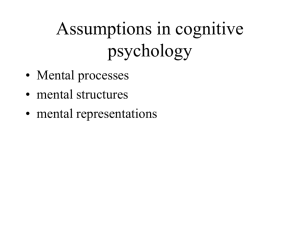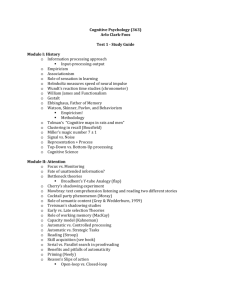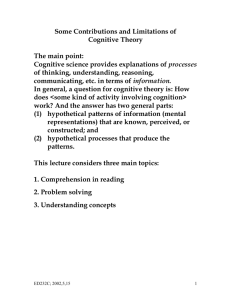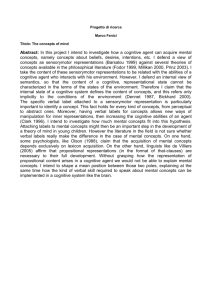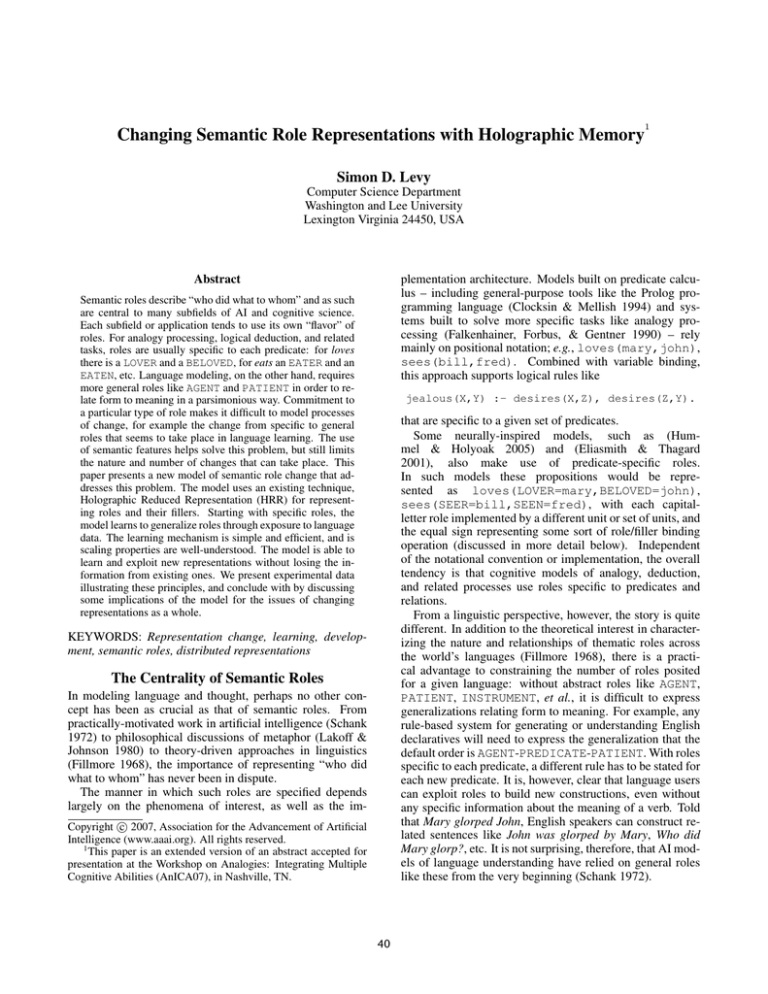
1
Changing Semantic Role Representations with Holographic Memory
Simon D. Levy
Computer Science Department
Washington and Lee University
Lexington Virginia 24450, USA
plementation architecture. Models built on predicate calculus – including general-purpose tools like the Prolog programming language (Clocksin & Mellish 1994) and systems built to solve more specific tasks like analogy processing (Falkenhainer, Forbus, & Gentner 1990) – rely
mainly on positional notation; e.g., loves(mary,john),
sees(bill,fred). Combined with variable binding,
this approach supports logical rules like
Abstract
Semantic roles describe “who did what to whom” and as such
are central to many subfields of AI and cognitive science.
Each subfield or application tends to use its own “flavor” of
roles. For analogy processing, logical deduction, and related
tasks, roles are usually specific to each predicate: for loves
there is a LOVER and a BELOVED, for eats an EATER and an
EATEN, etc. Language modeling, on the other hand, requires
more general roles like AGENT and PATIENT in order to relate form to meaning in a parsimonious way. Commitment to
a particular type of role makes it difficult to model processes
of change, for example the change from specific to general
roles that seems to take place in language learning. The use
of semantic features helps solve this problem, but still limits
the nature and number of changes that can take place. This
paper presents a new model of semantic role change that addresses this problem. The model uses an existing technique,
Holographic Reduced Representation (HRR) for representing roles and their fillers. Starting with specific roles, the
model learns to generalize roles through exposure to language
data. The learning mechanism is simple and efficient, and is
scaling properties are well-understood. The model is able to
learn and exploit new representations without losing the information from existing ones. We present experimental data
illustrating these principles, and conclude with by discussing
some implications of the model for the issues of changing
representations as a whole.
jealous(X,Y) :- desires(X,Z), desires(Z,Y).
that are specific to a given set of predicates.
Some neurally-inspired models, such as (Hummel & Holyoak 2005) and (Eliasmith & Thagard
2001), also make use of predicate-specific roles.
In such models these propositions would be represented as loves(LOVER=mary,BELOVED=john),
sees(SEER=bill,SEEN=fred), with each capitalletter role implemented by a different unit or set of units, and
the equal sign representing some sort of role/filler binding
operation (discussed in more detail below). Independent
of the notational convention or implementation, the overall
tendency is that cognitive models of analogy, deduction,
and related processes use roles specific to predicates and
relations.
From a linguistic perspective, however, the story is quite
different. In addition to the theoretical interest in characterizing the nature and relationships of thematic roles across
the world’s languages (Fillmore 1968), there is a practical advantage to constraining the number of roles posited
for a given language: without abstract roles like AGENT,
PATIENT, INSTRUMENT, et al., it is difficult to express
generalizations relating form to meaning. For example, any
rule-based system for generating or understanding English
declaratives will need to express the generalization that the
default order is AGENT-PREDICATE-PATIENT. With roles
specific to each predicate, a different rule has to be stated for
each new predicate. It is, however, clear that language users
can exploit roles to build new constructions, even without
any specific information about the meaning of a verb. Told
that Mary glorped John, English speakers can construct related sentences like John was glorped by Mary, Who did
Mary glorp?, etc. It is not surprising, therefore, that AI models of language understanding have relied on general roles
like these from the very beginning (Schank 1972).
KEYWORDS: Representation change, learning, development, semantic roles, distributed representations
The Centrality of Semantic Roles
In modeling language and thought, perhaps no other concept has been as crucial as that of semantic roles. From
practically-motivated work in artificial intelligence (Schank
1972) to philosophical discussions of metaphor (Lakoff &
Johnson 1980) to theory-driven approaches in linguistics
(Fillmore 1968), the importance of representing “who did
what to whom” has never been in dispute.
The manner in which such roles are specified depends
largely on the phenomena of interest, as well as the imc 2007, Association for the Advancement of Artificial
Copyright Intelligence (www.aaai.org). All rights reserved.
1
This paper is an extended version of an abstract accepted for
presentation at the Workshop on Analogies: Integrating Multiple
Cognitive Abilities (AnICA07), in Nashville, TN.
40
Evidence for Changing Role Representations
represented is fixed at some arbitrary hard limit, and a single
corrupt memory location or broken pointer can wreck an entire structure. Similar issues arise in feature-based representations like Head-Driven Phrase Structure Grammar (Pollard
& Sag 1994), and in connectionist models based on “grandmother cell” representations, like temporal synchrony networks (Shastri & Ajjanagadde 1993).
In a distributed representation, on the other hand, each
entity is represented by a pattern of activity distributed over
many computing elements, and each computing element
is involved in representing many different entities (Hinton
1984). In addition to being more obviously similar to the
way that the brain seems to represent concepts, such representations have a number of appealing properties for cognitive modeling (McClelland, Rumelhart, & Hinton 1986):
they are robust to noise, provide realistically “soft” limits
on the number of items that can be represented at a given
time, and support distance metrics. These properties enable
fast associative memory and efficient comparison of entire
structures without breaking down the structures into their
component parts.
The present work takes its inspiration from the framework
of Cognitive Grammar (Langacker 1987), with its emphasis
on general cognitive mechanisms and learning from examples. In such a framework, one sort of role conceptualization
is seen as developmentally prior to, but crucially related to,
the other. Because children can reason about the world well
before they acquire adult-level language competence, many
cognitive grammarians (notably (Tomasello 1992)) favor a
view in which general roles emerge from predicate-specific
roles through exposure to language. Although this is the
approach taken in the experiments described below, it is important to emphasize that the main issue is relating and integrating the two sorts of roles using a single mechanism.
The model makes no commitment to a particular direction
of change (specific → general or general → specific), and
can accommodate either.
In English and many other languages, information about
thematic roles is conveyed primarily through word order
(dog bites man vs. man bites dog). As detailed in (Tomasello
1992), adults’ consistent use of word order provides the language learner with an opportunity to generalize roles across
different predicates, once the the learner has acquired the
concepts associated with particular words, plus the general lexical categories noun and verb. Repeated examples
of correspondences between representational components
(noun/filler, verb/predicate) supports integration of different
structures into a single conceptual representation.
For example, a child learning English will be provided with numerous consistent associations between simple
declarative sequences of the form
nouni ... verbj ... nounk
Distributed Representation of Role/Filler
Bindings
The best known distributed representations approach is
probably the Latent Semantic Analysis (LSA) model of
word meaning (Landauer & Dumais 1997), which has
proven successful in many application domains. LSA is not
however a model of role/filler binding, for which a number of distributed representation approaches have been developed. The approaches that have enjoyed the most success recently can be grouped under the heading Vector Symbolic Architectures, or VSAs (Gayler 2003). VSAs trace
their origin to the tensor product representations presented
in (Smolensky 1990). Tensor-product models represent both
fillers and roles as vectors of binary or real-valued numbers.
Binding is implemented by taking the tensor (outer) product of a role vector and a filler vector, resulting in a mathematical object (matrix) having one more dimension than the
filler. Given vectors of sufficient length, each tensor product will be unique. Bundling – the combination of role/filler
bindings into a complete proposition – can be implemented
as element-wise addition (Figure 1). Bundled structures can
then be used as roles, opening the door to recursion. To
recover a filler (role) from a bundled tensor product representation, the product is simply divided by the role (filler)
vector.
Because the dimension of the tensor product increases
with each binding operation, this method suffers from the
well-known curse of dimensionality (Bellman 1961). As
more binding is performed, the size of the representation
grows exponentially. The solution is to collapse the N × N
role/filler matrix back into a length-N vector. The most
popular approach to doing this is called Holographic Reduced Representations, or HRR (Plate 1991), in which the
sum of each diagonal is taken, with wraparound (circular
convolution) keeping the length of all diagonals equal (Figure 2). In HRR, roles and fillers are represented as very
(1)
and conceptual structures of the form
predicatej (rolej,l = entityi , rolej,m = entityk )
(2)
The child eventually induces the generalized form
predicatej (rolel = entityi , rolem = entityk )
(3)
where rolel is AGENT and rolem PATIENT. A similar story
obtains for “free word order” languages like Russian and
Japanese, with noun endings taking the place of word order
in conveying thematic roles.
Issues in Representation
Cognitive models are often categorized in terms of the connectionist vs. symbolic distinction. In addition to being descriptively unhelpful, these terms are also typically conflated
with a host of issues that may have nothing to do with the
commitments entailed by a particular model.
A more useful distinction among cognitive representations is whether they are local or distributed (van Gelder
1999). Traditional symbol systems (grammar, predicate calculus) use local representations: a given symbol has no internal content and is located at a particular address in memory.
Although well-understood and successful in a number of domains, such representations are biologically unrealistic and
suffer from brittleness. The number of possible items to be
41
ally added into the representation of that structure, through
element-wise addition. For example, the proposition expressed by Mary loves John can be represented as
JOHN + MARY + LOVES + LOVER MARY + BELOVED JOHN (4)
where each capitalized word stands for the vector representation of the corresponding role or filler, + is vector addition,
and is the binding operation. Bundling the representations
of JOHN, MARY, and LOVES together with the role/filler
bindings supports efficient similarity-based retrieval of surface information (who was involved? what was done?) without the need to perform the unbinding operation. (This is
necessary because the binding operation results in a vector that is bears no similarity to its role or filler components.) By using bundles as fillers, recursive structures of
arbitrary complexity can be built, subject to the “soft limit”
phenomenon mentioned above.
HRR has been used successfully in modeling analogy,
with results similar to those found in experiments with human subjects (Eliasmith & Thagard 2001). Because the concept of binding is general enough to encode sequencing information (absolute position of a word or its position relative
to another), HRR has also been used to model word order in
a psychologically realistic way (Jones & Mewhort 2007).
Figure 1: Tensor product representation of John loves Mary
large (N > 1000 elements) vectors of random values drawn
from a fixed set or interval. Despite the size of the vectors,
the HRR approach is computationally efficient, requiring no
costly backpropagation or other iterative algorithm, and can
be done using the Fourier Transform, which is O(N logN ).
The price paid is that the crucial operations (circular convolution, vector addition) are a form of lossy compression
that introduces noise into the representations. The introduction of noise requires that the unbinding process employ a
cleanup memory to restore the fillers to their original form.
The cleanup memory can be implemented using Hebbian
auto-association, like a Hopfield Network (Hopfield 1982)
or Brain-State-in-a-Box model (Anderson et al. 1977). In
such models the original fillers are attractor basins in the
networks dynamical state space. These methods can be simulated by using a table that stores the original vectors and
returns the one closest to the noisy version.
Learning Thematic Roles with Holographic
Representations
We conducted three simple experiments to simulate learning of thematic roles from word order. These experiments
tested the ability of an HRR-based model to incorporate thematic roles into a fixed set of predicates and arguments,
while maintaining the information from predicate-specific
roles useful for other cognitive tasks.
The training set consisted of HRR’s for 50 two-place
predicates like LOVES and SEES, and 10 fillers like JOHN
and MARY. A simplifying constraint was that no predicate
was allowed to have the same filler in both roles. The arrangement resulted in 4500 (= 50 × 10 × 9) unique propositions. Predicates, fillers, and roles were represented as
3000-dimensional vectors of Gaussian-distributed random
numbers
with mean of zero and a standard deviation of
1/3000, following the suggestion in (Plate 1991). Propositions were constructed as in example (4) above. To simulate exposure to word-order consistencies as in (1) and
( 2) above, we used a random vector v1 to represent the
order noun ... verb and another vector v2 to represent
verb ... noun. The initial propositional HRR structures were
rebuilt by replacing the predicate-specific first role with itself plus v1 , and the second role with itself plus v2 , and rebinding these summed roles to their fillers.
Figure 2: Holographic Reduced Representation of the structure in Figure 1
Experiment 1: Incorporating Thematic Roles
To model the incorporation of thematic roles, we took the
vector average of all the integrated agent roles, thereby obliterating predicate-specific information. This average agent
role was used as the cue to retrieve a filler from the HRR
of each proposition. We did the same for the patient roles.
When everything (predicates, roles, fillers) can be represented with a set of uniformly-sized objects(vectors), all
sorts of information about a given structure can be liter-
42
Successful retrieval implies the ability to use a given proposition in various grammatical constructions, including ones
to which the model has not been exposed. Retrieval was
determined to be successful when the vector cosine of the
(noisy) retrieved filler was highest with the original filler
used to build the HRR for the proposition (as opposed to
any of the other 10 possible fillers). Because we required
both fillers to be retrieved successfully, chance performance
on this task is 1%. In 10 trials with different sets of random vectors, we achieved a mean success of 99.8%, with a
standard deviation of 0.5%. This result shows that the fillers
of thematic roles were successfully recovered despite these
roles being integrated with the predicate-specific roles.
Experiment 2: Does Representation Change Hurt
Performance?
Figure 3: Principal Components Analysis of role vectors.
Top left: before addition of theta roles. Top right: after addition of theta roles. Bottom: detail from top right.
As discussed earlier, many kinds of cognitive processing require representations of propositional content that support
querying the specific, concrete role played by a given entity. A representation of Mary loves John, for example, must
report Mary’s role as LOVER, and not merely something
general like thematic role AGENT. To test the retrieval of
these predicate-specific roles after the representation change
to thematic roles, we used the fillers in each proposition as
retrieval cues. As in the experiment above, the results were
highly successful: both of the concrete roles were retrieved
correctly 97.5% of the time, with a standard deviation of 5%
over the 10 trials (chance << 1%). As in the first experiment, the integration of both role components into a single
representation did not adversely affect the ability to retrieve
crucial information. The model supports both linguistic and
non-linguistic processes in a single, coherent representation.
Dealing with the credit-assignment problem will likely require a more sophisticated notion of “component” than the
one offered in the traditional AI literature. Figure 3 shows
a principal components analysis (Shlens 2005) of role vectors from the first two experiments, before and after thematic
role incorporation. (The axes correspond to the two dimensions with the highest eigenvalues.) As the middle image in
the figure suggests, there is indeed a strong internal structure to the HRR representations, which reveals how they
support the behavior found in these experiments. Qualitatively, there are two broad role categories. A closer look
at this structure (rightmost image) reveals a level of detail
beyond the high-level agent/patient distinction visible in the
middle image – quantitatively, there are still as many role
categories as there were originally. Although this data was
admittedly constructed to have exactly these properties, the
general point remains valid: to move forward, AI will need
new models of representation that support structure at many
levels of detail, and that support representation change without re-engineering.
A precise treatment of the scalability issue is well beyond
the scope of the present work. The appendices in (Plate
2003) provide an exhaustive analysis of the capacity of HRR
and convolution-based memories in general. The two main
results of this analysis are (1) a linear increase in capacity
as the length of the vectors increases and (2) an exponential increase in the required length as the average similarity of the vectors increases. Together, these results suggest
that vector-based architectures will benefit as much as traditional architectures from Moore’s-Law increases in memory
and processor speed, while offering psychologically more
realistic behavior (confounding of similar items, short-term
memory effects, etc.).
Discussion
Criticism of distributed representations and other neurallyinspired approaches has come from two directions. Some
cognitive scientists have claimed that such representations
cannot arrive at or exploit systematic, compositional structure of the sort used in traditional cognitive science and AI
(Fodor & Pylyshyn 1988). A minimum requirement noted
by these critics was that a model that could represent the
idea John loves Mary should also be able to represent Mary
loves John (systematicity) and to represent John, Mary, and
loves individually in the same way in both (compositionality).
From the preceding discussion it should be clear that
Holographic Reduced Representations (and other Vector
Symbolic Architectures) address these issues – specifically,
by providing operators (binding, bundling) that compose
structure is a systematic way, instead of treating on compositionality and systematicity as emergent properties.
A second set of criticisms has come from proponents of
traditional AI (Minsky & Papert 1988). Such critics worry
about the assignment of credit to the right component of a
system in which information is distributed among all representational elements, as well as the ability of such systems
to scale up to larger, real-world applications.
Conclusions and Future Work
This paper has presented some preliminary results in using
a novel computational medium, holographic / convolution
43
References
memory, to model a important of representational change:
the change from specific to general semantic roles that seems
to take place in language learning. Crucially, the results
show that this medium can accommodate the new representation without hurting the existing one. As compared with
traditional discrete (localist) symbol systems like grammars,
holographic memory offers a more supple, psychologically
plausible basis for representing this kind of change. The
ability to seamlessly integrate linguistic information into existing, pre-linguistic representations opens the door to exploring longstanding hypotheses on the possibility that language can influence thought (Whorf 1939).
Anderson, J.; Silverstein, J.; Ritz, S.; and Jones, R. 1977.
Distinctive feathers categorical perception and probability
learning: some applications of a neural model. Psychological Review 84(5):413–451.
Bellman, R. 1961. Adaptive Control Processes. Princeton
University Press.
Bowerman, M. 1982. Evaluating competing linguistic
models with language acquisition data: Implications of developmental errors with causative verbs. Quaderni di semantica 3.
Chomsky, N. 1966. Cartesian Linguistics: A Chapter in
the History of Rationalist Thought. New York: Harper and
Row.
Clocksin, W., and Mellish, C. 1994. Programming in Prolog. Berlin: Springer Verlag.
Dominey, P.; Hoen, M.; and Inui, T. 2006. A neurolinguistic model of grammatical construction processing. Journal
of Cognitive Neuroscience 18:2088–2107.
Eliasmith, C., and Thagard, P. 2001. Integrating structure
and meaning: a distributed model of analogical mapping.
Cognitive Science 25(2):245–286.
Falkenhainer, B.; Forbus, K. D.; and Gentner, D. 1990.
The structure-mapping engine: Algorithm and examples.
Artificial Intelligence 41:1–63.
Fillmore, C. 1968. The case for case. In Bach, E., and
Harms, R., eds., Universals in Linguistic Theory. Holt,
Rinehart. 1–90.
Fodor, J., and Pylyshyn, Z. 1988. Connectionism and cognitive architecture: A critical analysis. Cognition 28:3–71.
Gayler, R. 2003. Vector symbolic architectures answer jackendoffs challenges for cognitive neuroscience. In
Slezak, P., ed., ICCS/ASCS International Conference on
Cognitive Science, CogPrints, 133–138. Sydney, Australia:
University of New South Wales.
Gibson, J. J. 1977. The theory of affordances. In Shaw, R.,
and Bransford, J., eds., Perceiving, acting, and knowing:
Toward an ecological psychology. Hillsdale, NJ: Lawrence
Erlbaum Associates. 67–82.
Hinton, G. 1984. Distributed representations. Technical
Report CMU-CS-84-157, Computer Science Department,
Carnegie Mellon University.
Hummel, J. E., and Holyoak, K. J. 2005. Relational reasoning in a neurally-plausible cognitive architecture: An
overview of the lisa project. Current Directions in Pychological Science 14(3):153–157.
Jones, M. N., and Mewhort, D. J. K. 2007. Representing
word meaning and order information in a composite holographic lexicon. Psychological Review 114.
Kohonen, T. 2001. Self-Organizing Maps. Secaucus, NJ:
Springer-Verlag, 3 edition.
Lakoff, G., and Johnson, M. 1980. Metaphors We Live By.
University of Chicago Press.
Landauer, T. K., and Dumais, S. T. 1997. A solution to
plato’s problem: The latent semantic analysis theory of the
There are several pieces are missing from our current
story. One question not addressed in the experiments is
the issue of generalization to unseen examples. Consider,
for example, the situation of a first-language learner who
has pre-linguistic mental representations for a number of action predicates and their roles, and who has heard linguistic
exemplars for similar predicates. There is ample evidence
that learners generalize, and even over-generalize, thematic
roles in these situations: Bowerman (1982) provides examples like Don’t you fall me down. Because the notion “similar” has a precise mathematical interpretation in a vectorspace representation, it should be possible to use vectorspace learning methods, like the Self-Organizing Map (Kohonen 2001), to model this sort of generalization.
A second, related question concerns the genesis of the
predicates and roles themselves. We have simply assumed
the existence of a “lexicon” of predicates, each with a set
of roles, without worrying about how such elements might
emerge from the pre-linguistic experience of an individual –
i.e., from perception and action in the world. A longstanding tradition in philosophy, stretching from Plato through
Descartes to Chomsky (1966), bypasses this question by assuming the existence of “innate ideas” that each human being is born with. Recently, some cognitive scientists (e.g.
Steedman 2002) have begun to explore the more interesting possibility of relating predicate/role representations to
the theory of affordances in animal behavior (Gibson 1977).
We might speculate on the possibility of a system that would
take as input a visual representation of an event and a visual
representation of one of the participants, and would return a
representation of the role played by the participant.
Also missing in our story is an explicit mechanism for
transducing role representations to/from word sequences.
Modeling these mechanisms in a neurally realistic manner
is an active research topic (Dominey, Hoen, & Inui 2006).
The work presented here represents a first step toward integrating such “surface-level” information with a sufficiently
rich semantic representation in a neurally plausible way.
Acknowledgments
The author thanks Ross Gayler, Harry Howard, Pentti Kanerva, and Tony Plate for inspiration and useful suggestions
on an earlier version of this paper.
44
acquisition, induction, and representation of knowledge.
Psychological Review 104:211–240.
Langacker, R. W. 1987. Foundations of Cognitive Grammar. Stanford University Press.
McClelland, J.; Rumelhart, D.; and Hinton, G. 1986. The
appeal of parallel distributed processing. In Rumelhart, D.,
and McClelland, J., eds., Parallel Distributed Processing:
Explorations in the Microstructure of Cognition, volume 1.
MIT Press.
Minsky, M. L., and Papert, S. A. 1988. Perceptrons. MIT
Press.
Plate, T. 1991. Holographic reduced representations. Technical Report CRG-TR-91-1, Department of Computer Science, University of Toronto.
Plate, T. A. 2003. Holographic Reduced Representation:
Distributed Representation for Cognitive Science. CSLI
Publications.
Pollard, C. J., and Sag, I. 1994. Head-Driven Phrase Structure Grammar. Chicago: University of Chicago Press.
Schank, R. C. 1972. Conceptual dependency: A theory
of natural language understanding. Cognitive Psychology
3(4):pages 532–631.
Shastri, L., and Ajjanagadde, V. 1993. From simple associations to systematic reasoning. Behavioral and Brain
Sciences 16(3):417–494.
Shlens, J.
2005.
A tutorial on principal component analysis. Technical report, Systems Neurobiology Laboratory, Salk Insitute for Biological Studies,
http://www.snl.salk.edu/ shlens/pub/notes/pca.pdf.
Smolensky, P. 1990. Tensor product variable binding and
the representation of symbolic structures in connectionist
systems. Artificial Intelligence 46:159–216.
Steedman, M. 2002. Plans, affordances, and combinatory
grammar. Journal Linguistics and Philosophy 25(5-6).
Tomasello, M. 1992. First Verbs: A Case Study of Early
Grammatical Development. Cambridge University Press.
van Gelder, T. 1999. Distributed versus local representation. In The MIT Encyclopedia of Cognitive Sciences.
Cambridge, Massachusetts: MIT Press. 236–238.
Whorf, B. L. 1939. The relation of habitual thought and
behavior to language. In Duranti, J. A., ed., Linguistic Anthropology: A Reader. Oxford, UK: Blackwell Publishers.
45

